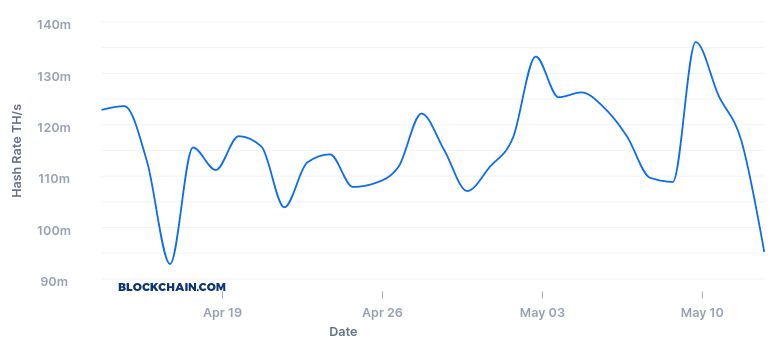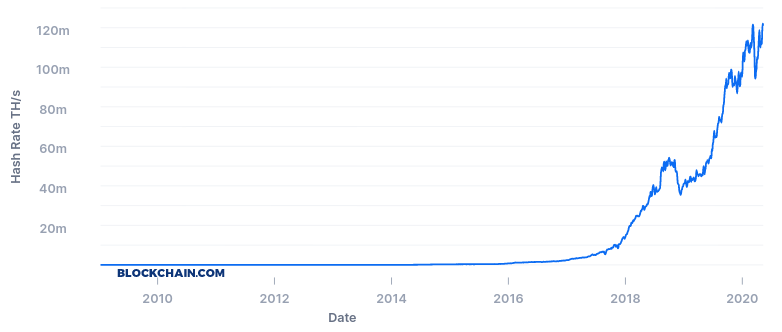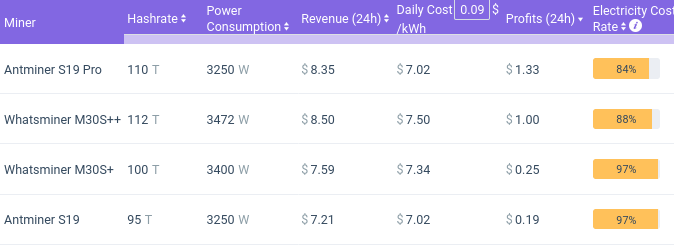The Bitcoin Halving Slashed the Network's Hashrate
Bitcoin's hashrate has fallen since its May 11 halving, but long-term the network remains healthy.

Key Takeaways
- Bitcoin's hashrate fell by 30% between May 9 and May 12 because of the halving.
- Mining remains profitable for miners with efficient machines despite the drop in total hashrate.
- The network is behaving the way it did in previous halvings, indicating healthy long-term growth.
- Declining profitability will put hobbyist miners out of business, further centralizing mining in China.
Share this article
Bitcoin’s hashrate has declined since the halving—an expected result of reduced block rewards. The falling network hashrate has a few interesting implications.
The halving reduced miner block rewards from 12.5 to 6.25 BTC, reducing inflation on the network and discouraging firms from mining new coins.
Bitcoin Hashrate Down By 30%
Total network hashrate is the amount of computational power dedicated to mining new BTC across the network. Based on data from Blockchain.com, Bitcoin’s hashrate fell from 136 exahashes to 95 exahashes between May 9 and May 12, representing a 30% drop in the network’s total hashrate.

Nonetheless, network hashrates fluctuate regularly. The fluctuation after the halving is a normal part of mining. Revenues from mining Bitcoin have halved. As a consequence, the network hashrate will drop as miners take older machines offline.
That said, the drop has barely affected long-term trends. Since 2008, Bitcoin’s hashrate has grown consistently over the long term, even after its past halvings in 2012 and 2016.

With these characteristics in mind, Bitcoin’s hashrate will continue to rise despite this week’s drop as mining devices get more efficient (and as Bitcoin prices continue to increase).
Mining Remains Profitable
Bitcoin miners use specialized ASIC devices that produce many more hashes than conventional computer hardware. Yet, electricity costs and depreciation also come into play. Older devices consume more electricity, meaning that high electricity bills can reduce mining profits to zero for some ASICs, or even result in losses.
Nonetheless, the latest ASIC mining devices are still moderately profitable because of their energy-efficient designs. The Antminer S19 pro, for example, brings in mining profits of $1.29 per day based on an electricity cost of $0.09/kWH. Electricity rates above $0.09 are no longer profitable, putting many hobbyist miners out of business and further centralizing mining the hands of mostly Chinese miners.

Mining revenues have decreased by 50%, so it may come as a surprise that the network hashrate only dropped by 30%. There are several reasons for this phenomenon. Less efficient miners tend to deploy in regions with cheap electricity. Additionally, some miners operate at a loss, expecting a long-term increase in Bitcoin prices.
Miners are BTC Price Sensitive
If this year’s halving succeeds in driving up Bitcoin prices in the future, Bitcoin mining could become profitable for older devices in the future.
Based on past halvings, it could take several months for that to happen. Bitcoin prices are volatile, as always. Although Bitcoin prices are rising and approaching $10,000, it is not necessarily a sign of a long-term rally since prices plunged before the halving.
Meanwhile, miners will begin to mine other coins that rely on Bitcoin’s SHA-256 hash function. Bitcoin Cash, for example, saw its hashrate increase from 1.4 exahashes to 3.4 exahashes between May 10 and May 12, indicating that some miners moved to the altcoin.
Nevertheless, Bitcoin will remain the focus for miners. The current emission rate of 900 BTC per day equates to revenues of $8.5 million across the entire network, meaning that mining will remain lucrative for specialized firms.
Share this article
